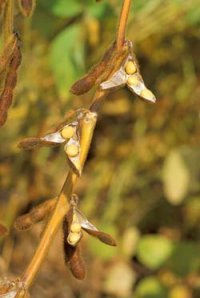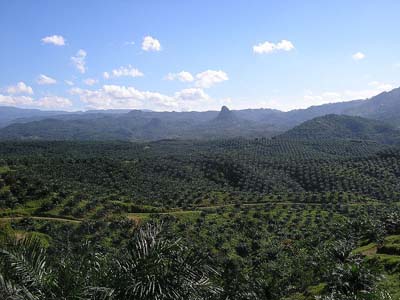Each of These Biodiesel Crops
Has Its Own Incentive...
Search this site!
Biodiesel crops are harvested and pressed in oil presses to extract the vegetable oil (SVO). The oil is then mixed with a catalyst and methanol. It goes through a process called
transesterification
to produce this biofuel. Biodiesel can also be made from
waste vegetable oil (WVO),
and animal fats. Each source of oil has unique benefits.
 Here is the primary American way of producing SVO:
Soybeans.
Here is the primary American way of producing SVO:
Soybeans.
Soybeans are America's primary source of biodiesel feedstock (90% in 2006). They can produce 48 gallons of oil per acre. Soy plants grow well in America. Soybeans were one of the largest crops in 2000.
And here is a futuristic way:Scientists are working to produce biodiesel from algae. Harvested oil can be up to 10,000 gallons per acre! It is perhaps the most lucrative of crops. It is estimated to produce far more oil per acre than any other plant grown for fuel. Victor Lin is the leading reasearcher for using
nanofarming technology
(opens in new window) which could dramatically change how biodiesel is produced.
 Other popular sources for producing SVO are:
Other popular sources for producing SVO are:
•
Palm
, which can produce an astounding 635 gallons of oil per acre, has the highest oil yield of plants currently grown for biodiesel feedstock. It is mainly grown in Malaysia and Indonesia. It does pose some environmental concerns though. These concerns are discussed on the 'Palm' page link above.
Photo courtesy of Achmad Rabin Taim
•
Jatropha
seeds can contain up to 40% oil, producing an average of 202 gallons of oil per acre. Another benefit is that this plant can thrive in marginal lands. Also, the seeds are poisonous; therefore using this as a biodiesel crop would not compete with food supply.
•
Canola
is a genetically modified type of rapeseed. It will produce an average of 100 gallons of oil per acre. In 2008/2009, it was the third most produced vegetable oil in the world!
Here are Some of the Less Common Feedstock Crops:
• Mustard seed is a type of rapeseed. It contains 25-40% oil. The meal left over after processing can be used as an organic pesticide.
• Radish - wild radish can contain up to 48% oil, and is drought tolerant.
• Sunflower produces an average of 102 gallons of oil per acre.
• Castor bean averages 151 gallons of oil per acre.
• Coconut produces approximately 287 gallons per acre.
• Moringa seeds contain 30-40% oil; the rest of the plant can be used as food.
Return from 'Biodiesel Crops' to 'Biodiesel Homepage'